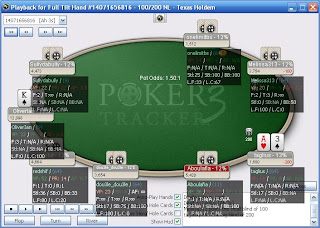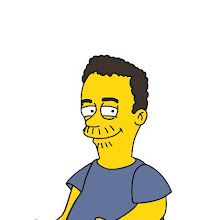
Still on my self-imposed 48-hour ban. I'm itching to play, but resisting the temptation...
Here's something I've been meaning to post for awhile, a description of my HUD configuration while playing online. A screenshot of my HUD is above. The first thing you might notice is that the table being displayed is not a table from one of the normal poker sites. Instead, this table is the Poker Tracker 3 Hand History replayer. In what might be the single greatest feature in the history of Poker software, PT3 now displays your HUD on the table of their own replayer! The numbers in the HUD are correct at the time of the hand being viewed, too. So, in this picture, you can see that I've got 64 hands of information for 5 players (including onelimittbs, and myself), only 9 hands of information for OliverIan and Sullydabully, and 11 hands for Aboulafia. If I were to play the next hand from this tourney in the replayer, these counts would go up by one, as would each player's stats based on his actions from this hand.
(Nevermind that I don't actually have the next hand from this tourney available, as this was the hand on which I was knocked out, lol).
Let's discuss the numbers in the HUD. The first row is the player's name and the number of hands I have in my database for him/her. If I were to ever play one of these players again, their stats would pick up right where they left off, giving me an all-important picture of that player's style before we play a hand of the new tourney.
Row 2 is the "holy trinity" of HUD stats - VPIP (Voluntarily put money in Pot), PR (preflop raise percentage), and AF (total aggression factor). These three stats tell me the most about each player.
Let's look at redshif, a real interesting player. He's in the lower left corner. I played 64 hands at the table with this player, and he has voluntarily put money into the pot in 52% of those hands. Over half! The next number, 14, means that he has raised preflop 14% of the total hands, meaning that he has limped 38% of the total hands (52-14=38). The last number on this row, his aggression factor, is 0.7. Because this number is less than 1, it tells me that this player is calling bets more often than he his betting or raising. In short, he's a calling station. He's limping into every pot, then calling, calling, calling if he hits any piece. And, of course, because he has a decent stack, we know that he's hitting his hands often enough in this tourney to be successful (at least to this point).
What I'm hinting at here is that the HUD stats help you go on tilt even faster as you watch the donkeys play every hand and build up big stacks of chips, because you have the exact numbers in front of you - proving how many hands they're playing, and how often they're just calling/calling/calling to the river. Ain't technology grand?
The next row of three numbers are also aggression factors, but separated out by street (flop, turn, and river). Redshif's value is near 1 (rounded) for the flop and river, and 0 for the turn. these are low numbers, and again they tell us that he's calling as often than he's betting or raising. I like separating the aggression out by street because it can help you see players who will c-bet on the flop, but then not bet the turn. Or you can see a player like dou3le_dou3le, who has an infinite aggression on all three streets, meaning that he has bet or raised every time he's been next to act. (this might be only 1 time, sample sizes are always in play here).
The next row shows Steal the Blinds percentage - basically the number of times the player has open raised from the button or cutoff. Note that redshif is doing this fairly often - about 1/3 of the times that he has been able to, he has raised from these late positions (the software assumes all raises from this position are "steals", not knowing if the player might actually have a good hand and is raising for value). The last two numbers on this row are the players "fold to a steal attempt" from the small and big blinds. These numbers are of course useful to know for the players on my left, as these are the players whose blinds I need to try to steal.
The last row is something I just added, and I think it's going to help me a great deal in my game. L.F stands for the percentage of times a player limped and then folded to a raise behind him. L.C stands for the percentage of times a player limped and then called a raise behind him. Look at redshif - he tends to fold after limping and being raised - he has done it 80% of the time (4 out of 5 times, in fact, you can mouse over any stat on the HUD to see the actual counts behind the percentages). Only 1 of the 5 times did he call the raise after a limp. This is a good guy to attempt stealing his limp with a raise from the blinds, even with no hand.
This last row actually helped decide which the way I played this hand. OliverIan open limped, and everyone else folded to me in the big blind. I had A3o. One possible play is to shove my ace here, but I chose not to do this for a few reasons:
1. Ace-rag is a statistical dog to the top 30% of hands (44-55%) - I'm crushed by higher aces, of course, am equally only about 30% to win against small pairs, and I'm only a small favorite against hands like KQ or JT. So if I'm shoving, I would rather hope the villain folds rather than calls.
2. my new HUD stats told me that the one time so far that this player limped and then was raised, he called that raise (100%). Sure, this is a sample size of one, but even one data point of information is useful in helping making a decision.
3. Villain has a big stack, probably making him more likely to call, rather than less likely.
So based on all of this information, I decided to take the free flop. The flop came AKK, and then I shoved. I figured the only way I would get a call was if the player had an ace or king, and any aces with higher kickers would chop with me if a higher card came on the turn or river. I've had other players suggest check-raising all in, if I felt the villain would have bet out, so at least I would have won some chips if villain had a hand like JT and took a stab at the high flop. This is admittedly the better overall play, but still assumes you're getting all your chips in the middle.
As you can see on the screenshot, the villain had Ks8s, so shoving into him didn't go so well. Whoopsie.
Anyway, that's my current PT3 HUD. Feedback is welcome. Have I missed any stats that you feel I shouldn't be living without in for SNGs?
And with this long post, I successfully kept my 48 hour self-imposed poker ban. Sweet.

2 comments:
Matt, what do you think of PT3 and the HUD in particular? I tried using HUD's and found them annoying. I also thought it might make me lazy and pay less attention to the action.
FG
I still pay attention to the action, because I'm always trying to decipher bet sizes. (some people always minbet, or bet bigger with big hands, etc).
I love my HUD, especially as I try to add tables (I play only one or 2 simultaneously at the moment).
Post a Comment